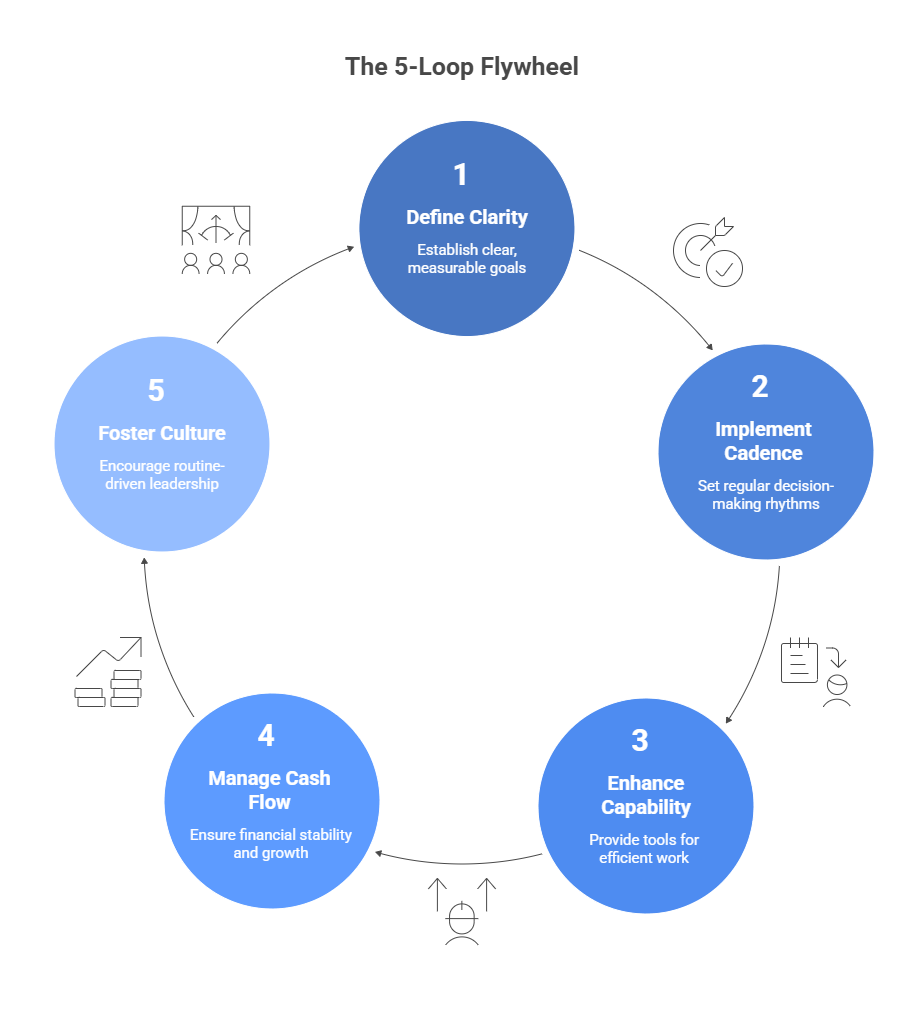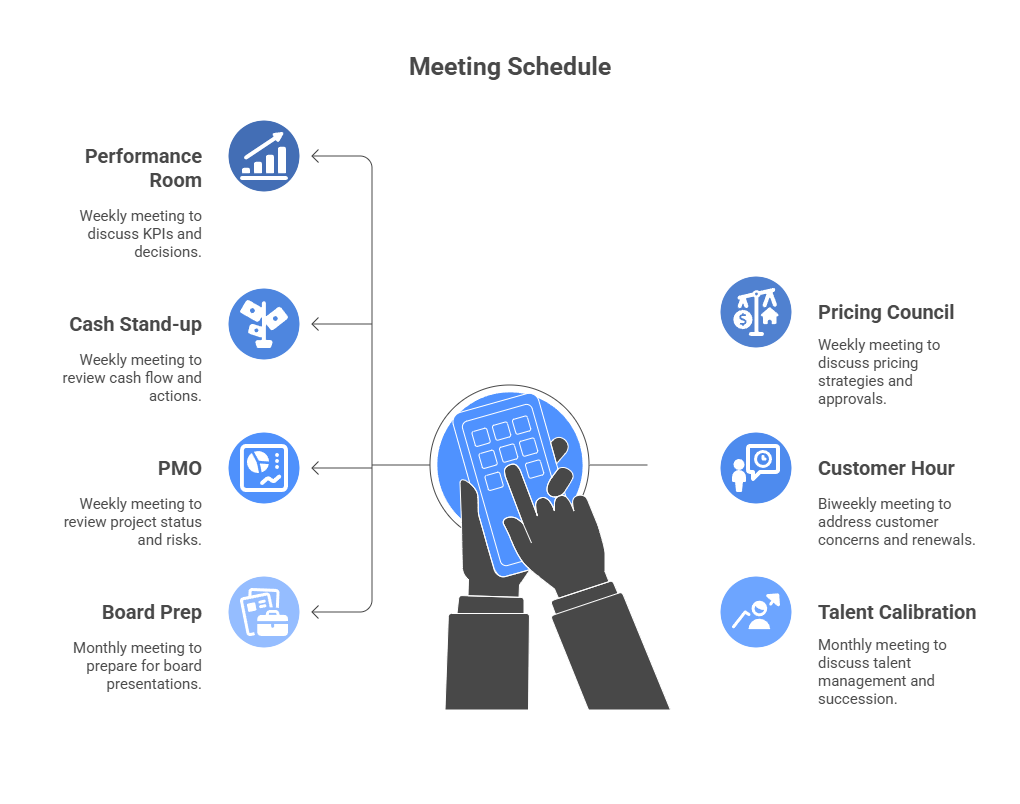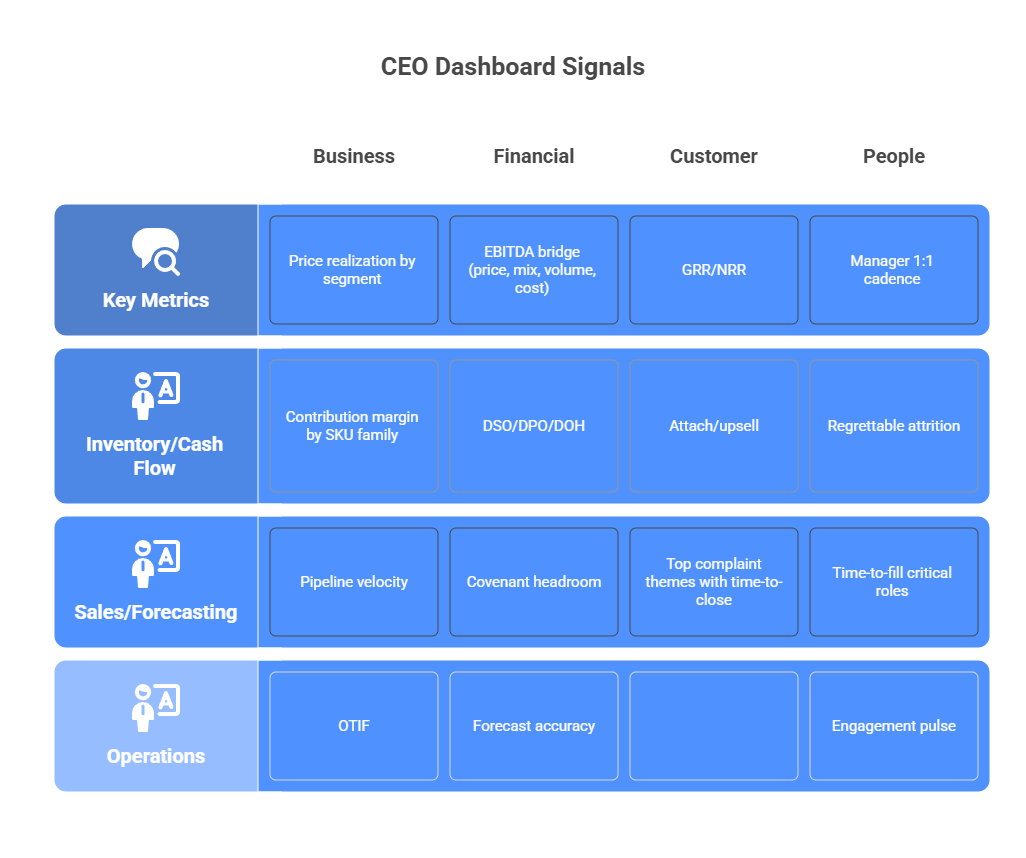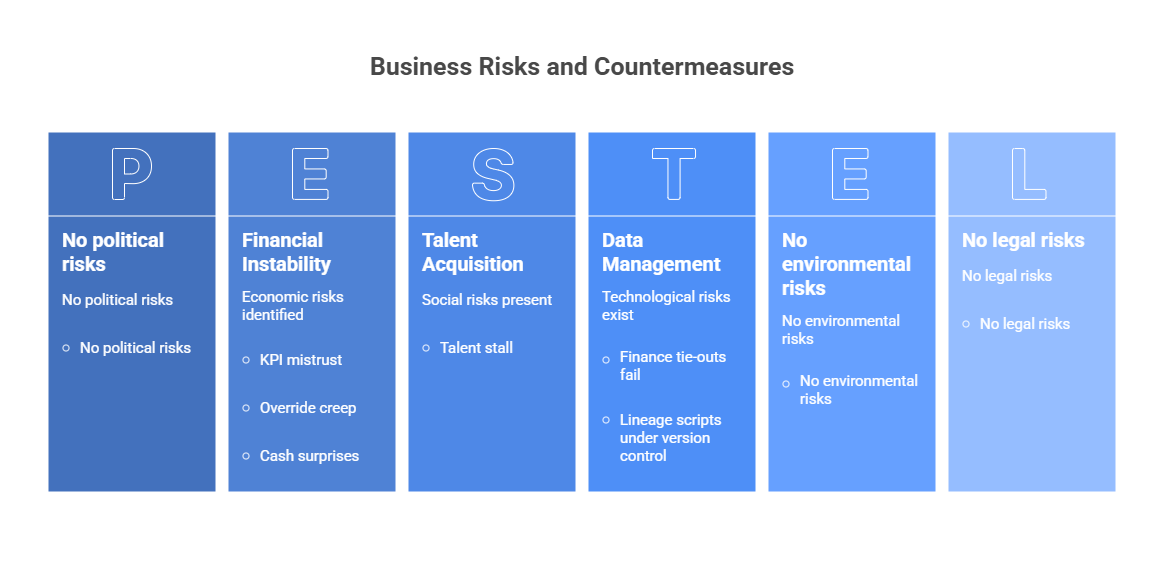CEO Enablement System: The 100-Day Flywheel That Sticks
Oct 25, 2025
Most CEO onboards start with announcements and slideware. The ones that work start with operating reality—cash, customers, and cadence—and then compound small, verified wins. This is a practical enablement system that turns the first 100 days into a flywheel of clarity, cadence, capability, cash, and culture.
The problem to solve
-
Plans are detached from cash and constraints.
-
Meetings consume time but don’t change decisions.
-
Metrics don’t reconcile to the ledger, so trust erodes.
-
Talent actions lag, leaving critical roles unfilled and misaligned.

The 5-loop flywheel
-
Clarity — define what “good” is in numbers. A one-page value bridge from revenue to EBITDA to equity value, with three needles you’ll move first.
-
Cadence — short, fixed rhythms that force decisions: weekly performance room, pricing council, 13-week cash, PMO. Same agenda, time-boxed, owners named.
-
Capability — put tools where work happens: CPQ rules for pricing bands, CTS drivers in the dashboard, dispute reason codes, S&OP lite, access controls.
-
Cash — every loop must show up in 13-week cash and covenant headroom. No initiative without a cash hypothesis and an owner.
-
Culture — leaders coach to the routines; recognition follows evidence. Meeting invites and decision logs signal priorities, not posters.
What changes on Monday
-
One value page: Equity Value = (EBITDA × Multiple) − Net Debt, with top three levers pinned to the next quarter.
-
One cash tile: beginning cash, receipts, disbursements, ending cash, headroom; variance code + owner for misses.
-
One pricing rulebook: floors, bands, approvals, override expiry; published in CPQ.
-
One performance room: a 45-minute weekly meeting that walks bridge → KPIs → actions; slides optional, decisions mandatory.
-
One issue log: red/amber items with owners and unblock requests; archived monthly.

The meeting spine (keep it light, keep it real)
-
Performance Room (weekly, 45 min): value bridge KPIs; top five deltas; decisions due this week.
-
Pricing Council (weekly, 30 min): realization, overrides, mix upgrades; rule change approvals.
-
Cash Stand-up (weekly, 30 min): forecast vs actual; AR disputes, AP batches, inventory actions.
-
Customer Hour (biweekly, 30 min): renewal risks, NRR drivers, top complaint verbatims.
-
PMO (weekly, 45 min): initiative RAG status, blocked items, evidence uploaded.
-
Talent Calibration (monthly, 60 min): critical roles, performance/values grid, succession next steps.
-
Board Prep (monthly, 45 min): preview of the story in numbers, not narratives.
Operating artifacts (buyer-grade from day one)
-
KPI lineage pack: definitions → scripts → ledger tie-outs (12-month truth set).
-
Price waterfall: List → Pocket with quarterly history and rule exports.
-
CTS model: drivers, allocation logic, and policy outcomes.
-
13-week cash snapshots: immutable monthly archive with bank tie-outs.
-
Decision register: what changed, when, with what result.

CEO dashboard (signals that actually steer)
Business: price realization by segment, contribution margin by SKU family, pipeline velocity, OTIF.
Financial: EBITDA bridge (price, mix, volume, cost), DSO/DPO/DOH, covenant headroom, forecast accuracy.
Customer: GRR/NRR, attach/upsell, top complaint themes with time-to-close.
People: manager 1:1 cadence, regrettable attrition, time-to-fill critical roles, engagement pulse.
Decision rights that prevent drift
-
Price: within bands—CRO; outside bands—CRO + CFO; lighthouse exceptions—CEO with expiry.
-
Cash: off-cycle payments—CFO only in cash stand-up; capex—CEO + CFO via hurdle gate.
-
Talent: critical role changes—CEO + CHRO after calibration; performance exits—line leader + HR with evidence.
-
Risk: incident severity 1—CIO/GC owns, CEO informed; public statements—CEO + GC only.
First five “no’s” that protect momentum
-
No new OKR set without ledger-tied KPIs.
-
No pricing overrides without reason code and expiry.
-
No “strategic” projects without a cash hypothesis and owner.
-
No dashboards without scripts and reconciliation notes.
-
No meetings without a decision log and next steps.
Evidence of progress (week 4, week 8, week 12)
-
Week 4: pricing bands live, override log running, cash tile reconciled 4/4 weeks.
-
Week 8: CTS policy changes piloted; DSO reduced by ≥2 days; performance room producing visible “stop/do” decisions.
-
Week 12: contribution margin uplift in two SKU families; NRR stable/improving; headroom trend up with variance error ≤10% (rolling two-week).
Risks and countermeasures

The exit-back angle
Buyers pay for verified routines. Package: value bridge with dated improvements, CPQ rule exports, CTS outcomes, 13-week cash archives, incident drill logs, and the decision register. The story that travels is one they can rerun in 30 minutes.
One-page checklist (print and stick on the wall)
-
Value bridge and KPI stack published; scripts stored; tie-outs done
-
Weekly performance room, pricing council, cash stand-up on calendar
-
CPQ bands live; override log with expiry running
-
CTS drivers measured; first policy changes landed
-
13-week cash reconciled weekly; variance closed with owners
-
Decision register and monthly archive maintained
VCII Note and Copyright
TVC Next reframes CEO onboarding as enablement: short cadences, ledger-tied metrics, and artifacts that survive turnover and scrutiny. The outcome is predictable cash and a narrative buyers and boards trust.
Copyright © 2025 VCII, Meritrium Corp. All rights reserved.
We have many great affordable courses waiting for you!
Stay connected with news and updates!
Join our mailing list to receive the latest news and updates from our team.
Don't worry, your information will not be shared.
We hate SPAM. We will never sell your information, for any reason.


